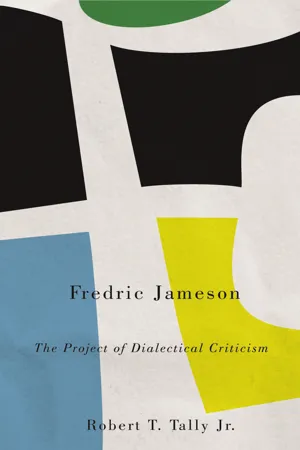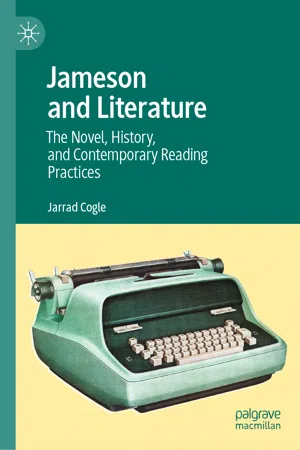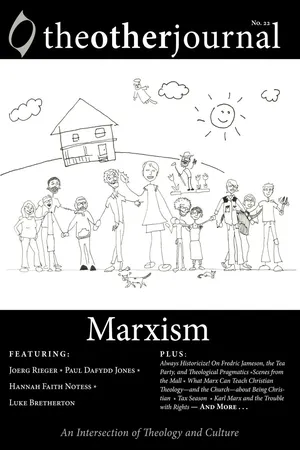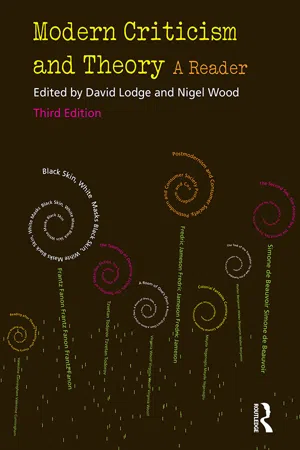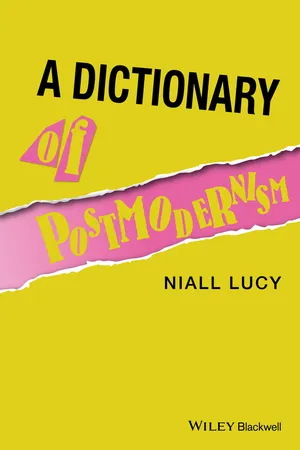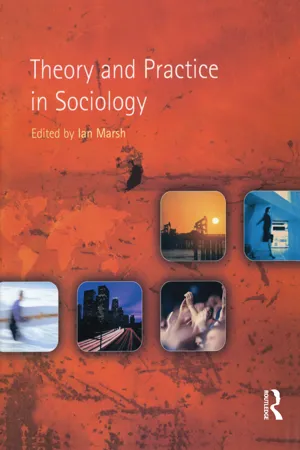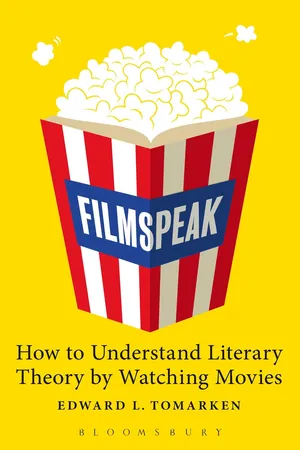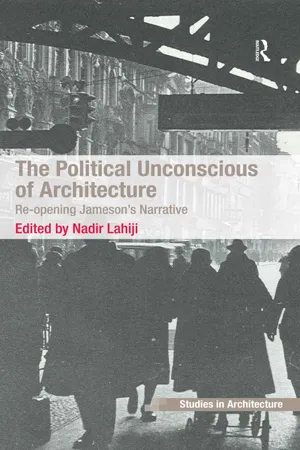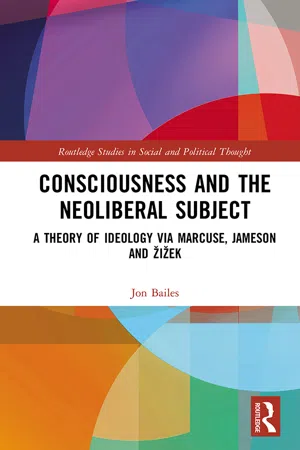Literature
Fredric Jameson
Fredric Jameson is a prominent literary critic and Marxist theorist known for his influential work on postmodernism and cultural theory. He is recognized for his analysis of the relationship between literature, history, and ideology, and his concept of "cognitive mapping" as a way to understand the complexities of contemporary society. Jameson's writings have had a significant impact on literary and cultural studies.
Written by Perlego with AI-assistance
Related key terms
Related key terms
1 of 4
Related key terms
1 of 3
10 Key excerpts on "Fredric Jameson"
- eBook - ePub
Fredric Jameson
The Project of Dialectical Criticism
- Robert T. Tally(Author)
- 2014(Publication Date)
- Pluto Press(Publisher)
Jameson’s dialectical criticism has reinvigorated Marxism by connecting its lessons to the cultural sphere, broadly imagined, and to the exigencies of theory in an era of globalization. Perhaps for this reason, his worldwide influence has been especially notable in eastern Asia and Latin America, emergent powers within the postmodern world system. What is more, as I will emphasize throughout this study, Jameson has been one of the most important literary thinkers in a time when literature, literary criticism, and literary theory, properly speaking, are considered by many to be passé or irrelevant, whether in the face of new media and technology or in contrast to other apparently pragmatic or utilitarian fields of study. Terry Eagleton, long considered Jameson’s chief rival amongst the leading Marxist critics in the English-speaking world, has enshrined him in a pantheon of modern critical theory. As Eagleton put it: There is surely no doubt that Fredric Jameson is not only an eminent critic but a great one, fit to assume his place in a roll-call of illustrious names stretching from Edmund Wilson, Kenneth Burke, F.R. Leavis and Northrop Frye to I.A. Richards, William Empson and Paul de Man. Even this is to limit the judgement to Anglophone colleagues only, whereas the true field of comparison ranges much more widely. No literary scholar today can match Jameson’s versatility, encyclopaedic erudition, imaginative brio or prodigious intellectual energy. In an age when literary criticism, like so much else, has suffered something of a downturn, with forlornly few outstanding figures in the field, Jameson looms like a holdover from a grander cultural epoch altogether, a refugee from the era of Shklovsky and Auerbach, Jakobson and Barthes, who is nonetheless absolutely contemporary. 1 Eagleton identifies a curious aspect of Jameson’s oeuvre : its simultaneous evocation of an august past and engagement with an utterly present, even seemingly near-future condition - eBook - ePub
Jameson and Literature
The Novel, History, and Contemporary Reading Practices
- Jarrad Cogle(Author)
- 2020(Publication Date)
- Palgrave Macmillan(Publisher)
5 , p. xi). Within this framework, despite extensive discussions of poetry, music, architecture and film, the novel has remained primary in his reading practice. My work will contend that Jameson’s idiosyncratic engagements with the literary canon—as well as his predilections and absences when discussing certain periods and forms—have an impact on his theoretical frameworks, particularly in his sense of historical change. If we make the concession that gaps are inevitable in any critical practice, several aspects of Jameson project nonetheless bring these questions of canonisation and textual choice to the fore: the immensity of his cultural knowledge and range of reference, his interest in generic boundaries and formulation, and his attempts to totalise and to make dialectic connections between disparate texts. By closely attending to Jameson’s literary readings, we also gain a new perspective on his overarching theoretical concepts, one that differs from many previous critical engagements. Through this work, this book seeks to articulate the tension between Jameson’s most influential work and the criticism that has surrounded it, while suggesting ways in which his literary interpretation might remain useful for contemporary reading practices. To recognise the specific nature and extent of Jameson’s engagement with literary studies, in other words, is not just to provide an account of his own literary criticism, but also to offer an alternative viewpoint of his cultural work as a whole.Major Contributions: Marxism, Symptomatic Reading and Postmodernism
Biographical information on Jameson is hard to come by. Books focusing on his career have given only summary biographical details before concentrating on his theory and achievements. In the framing of his contributions to theory as paradigmatic or foundational, however, there is often a restricted sense of Jameson’s connection to wider critical discourse. In some ways, his own publications exacerbate this impression. His major texts often engage specifically with an earlier generation of Marxist critics, with only brief references to contemporary academic discussion. As Geoffrey Galt Harpham notes: “Jameson’s works … seem to issue from a center of consciousness unconnected with … any kind of neighborly community. His first books appeared starkly without dedicatees, and, with the exception of his very first, in which he thanked his dissertation advisor, without the customary list of friends and colleagues and institutions who made it all possible” [6 , pp. 216–217]. The growing number of scholars mentioning Jameson in their own dedications and acknowledgements counteract this sense of the impersonal. Recently, former students have described Jameson as “a great teacher” [7 , p. xiii], or as a dissertation advisor with a “voracious interest in everything, keen and attentive guidance, and general good mood” [8 - eBook - ePub
- Other Journal(Author)
- 2013(Publication Date)
- Cascade Books(Publisher)
At the very least, I believe this method has demonstrated how theology is woven throughout one area of that which makes up the hypercomplex reality we call modern politics; it has helped us see what type of theology is being utilized within the Tea Party and why. If this is the case, it is entirely in keeping with the program of theological pragmatics that has been outlined and is thus believed by me to be useful. For the program of theological pragmatics operates on a principle of hope very similar to Jameson’s: namely, that when the numerous theologies that structure our impossibly complex world are taken up and critically examined within the tradition of the best theologians, the seeds of a changed world—a world closer to the New World—will be the unexpected result.65 . Although some (Derrida, Deleuze, Foucault) can be counted as Marxists in only a qualified sense.66 . See the jacket cover of Jameson, The Hegel Variations: On the “Phenomenology of Spirit” (London, UK: Verso, 2010) for example.67 . Jameson helped to introduce the Frankfurt school to his monolingual American audience in 1971’s Marxism and Form (Princeton, NJ: Princeton University Press). For a good introduction to the contemporary significance of Jameson as a theorist, see Sean Homer’s Fredric Jameson: Marxism, Hermeneutics, Postmodernism (New York, NY: Routledge, 1998) 1–7.68 . See, for example, Terry Eagleton’s “Fredric Jameson: The Politics of Style,” Diacritics 12, no. 3 (1982) 14–22.69 . Jameson, The Political Unconscious (Ithaca, NY: Cornell University Press, 1982) 383.70 . Jameson, Marxism and Form , 308.71 . Jameson, Valences of the Dialectic (London, UK: Verso, 2009) 9: “I believe that theory is to be grasped as the perpetual and impossible attempt to dereify the language of thought.” See also Jameson, Marxism and Form , 56–57, on Adorno’s writing of dialectical sentences. It may be objected that Jameson is not directly elaborating his own thought in these references. Yet I hold that his own writing practice in fact operates on these principles, even if he never sets out to directly claim them as his own.72 . See Jameson, Representing “Capital”: A Reading of Volume One (London, UK: Verso, 2011) 9, for Jameson’s thoughts on why it is productive to “return to Marx” in our present moment.73 . These organizing points of Jameson’s book are initially stated on pages 2 through 5 of Representing “Capital” - eBook - ePub
Modern Criticism and Theory
A Reader
- Nigel Wood, David Lodge(Authors)
- 2014(Publication Date)
- Routledge(Publisher)
33 Fredric Jameson
DOI: 10.4324/9781315835488-33Introductory note
Fredric Jameson (b. 1934) has taught at several American universities, including Harvard, the University of California at San Diego and Santa Cruz, and Yale. At present he is William A. Lane Professor of Comparative Literature and Romance Studies at Duke University. Since the publication of his Marxism and Form (1971) he has been generally acknowledged as the leading American exponent of marxist criticism, but his work also displays an intellectually powerful grasp of the whole range of structuralist and post-structuralist theory. The Prison House of Language: a critical account of structuralism and Russian formalism (1972) is a valuable exposition of structuralism and Russian Formalism, as well as a critique of them from the point of view of dialectical materialism. His Fables of Aggression (1979) is a study of fascist ideology in modernist writers such as Wyndham Lewis and Ezra Pound. The Political Unconscious: narrative as a socially symbolic act (1981) is a densely packed synthesis of structuralism, post-structuralism, Freudian psychoanalysis and various schools of marxism, but its main focus is on the critical and cultural lenses through which we read. We can never attain an unmediated acquaintance with any text and the hermeneutic process is essentially an allegorical one: we read through a master code, that changes, to be sure, but the pattern is largely the same. Literary or cultural texts attempt to resolve contradictions and we must be aware of the dialectic in which they are inexorably caught; we thereby return to history, not an account of events alone, but the ideologies and basic forces that always lie just off the textual map.More recently Jameson has turned his attention to the topic of postmodernism, and its socio-economic context of ‘late capitalism’. His attempts to provide a materialist explanation of its appeal do not lead to a simply antagonistic stance. ‘Postmodernism and Consumer Society’ was first published in the Hal Foster collection, Postmodern Culture (1983) and is his most succinct appreciation of postmodernist aesthetics. It was quickly followed by ‘The Politics of Theory: ideological positions in the postmodern debate’ in New German Critique, 33 (1984). A much expanded and elaborated version of this, entitled ‘Postmodernism, or the Cultural Logic of Late Capitalism’, was published in New Left Review (July/August 1984), and provided the basis for a full-length study with the same title that emerged in 1991. Casting his eyes over many artforms and media, he comes to the conclusion that the postmodern breaks away from modernism at the same time as ‘late capitalist’ forces, commodification and populist appeals to ‘choice’ and a free market, come to be felt and taken as a ‘natural’ derivation from social progress. Far from being radically unsystematic, postmodern aesthetics can be identified in terms of its typical effects and tropes – all of which strain to efface its history. Indeed, Jameson has tried to supply an optimistic vision of marxist analysis in his carefully-argued study of Brecht and Method (1998), his grasp of contemporary modernist thought in A Singular Modernity: essay on the ontology of the present (2002) and his celebration of utopian ideals in Archaeologies of the Future: the desire called Utopia and other science fictions - eBook - ePub
- Niall Lucy(Author)
- 2015(Publication Date)
- Wiley-Blackwell(Publisher)
Jameson, Fredric:
American Marxist cultural critic, born 1934Because we are alienated, we are postmodern; and we are alienated because we are subjects under capitalism. This is the broad thrust of Jameson’s argument in his influential magnum opus, Postmodernism, or, The Cultural Logic of Late Capitalism (1991), developed from an essay published in New Left Review in 1984. The argument is not quite that postmodernism begins with capitalism, but rather that what might be called capitalism’s alienation effect intensifies with each new stage or phase of capitalist history: since our alienation today, in the time of “late” capitalism, according to Jameson, has never been greater, our time is both historically unprecedented (hence postmodern) and historically inevitable (hence postmodern). This is to situate modernism in Marxist terms as the expression (the cultural superstructure) of the capitalist system (the economic base), a system owed to particular historical conditions associated with the shift in Europe from an agrarian to an industrial economy in the early nineteenth century. Postmodernism is simply the latest expression of that system in its current stage of “late” development.Jameson adapts his periodic approach to cultural history from the work of German Marxist theorist Ernest Mandel, whose Late Capitalism (1999 [Ger. 1972]) posits three broad stages of development: early capitalism spans roughly 1700–1850 in Europe, as industrial capital cultivates domestic markets; the middle period (1850 through to World War II) sees capital flow increasingly from domestic to foreign markets, aided by industrial and technological advances; and the so-called late stage, following the end of World War II, corresponds to capital’s global fluidity, unrestricted by national border controls. Each economic phase gives rise, for Jameson, to a matching superstructural phase: realism is the cultural dominant of the early-capitalist period; modernism, of the middle phase; and postmodernism, of the late-capitalist present. The local alienation caused by the consumption of goods produced in dark satanic mills thus grew into the postmodern “waning of affect” (Jameson, 1991: 9) that epitomizes the global mass consumption of commodities (goods, styles and images) produced by multinational corporations. This grim state of affairs is captured in the postmodern fascination with a “whole ‘degraded’ landscape of schlock and kitsch,” where the tumbleweeds of style and fashion – “of advertising and motels, of the late show and the grade-B Hollywood film [sic], of so-called paraliterature - eBook - ePub
- Ian Marsh(Author)
- 2014(Publication Date)
- Routledge(Publisher)
Politically, then, Lyotard’s approach is indeed rather limiting. Questions of power, inequality and social justice may occasionally appear in and through his critique of modernist meta-narrative domination, yet any account of the material conditions that may be seen to underpin such a transformation of knowledge and the holders of knowledge in these postmodern times is, perhaps inevitably, lacking. What Lyotard’s rejection of all matters of empirical truth and falsehood implies for the development of social theory is a matter that will be returned to later (see pp. 253–4).Frederic Jameson – postmodern Marxist or ‘having his cake and eating it'?
The theorists that have been examined so far in this chapter have, without doubt, been regarded within philosophy and the social sciences as in many ways personifying the postmodern approach. The work of Frederic Jameson, by contrast, is not quite no clearly categorised as such: Jameson has variously been categorised as postmodern cultural theorist, neo-Marxist and dialectical materialist (McGuigan 1999 ). Indeed, the reason that Jameson is such a fascinating theorist to examine in a chapter on postmodernism is precisely because of the potentially contradictory nature of his work, of the crossing over from Marxism to postmodernism and back again in a way that may anger the postmodern purist, yet which ironically represents what is arguably one of the most lucid yet simultaneously problematical accounts of postmodernity today. While Jameson’s credentials as a postmodernist may be questioned, what is not in doubt are the contributions that his work has made as a theorist of the postmodern. As the title of his seminal 1984 essay, ‘Postmodernism or the cultural logic of late capitalism’ makes explicit, for Jameson the term ‘postmodernism’ principally refers to the ‘cultural logic of late capitalism’. Accompanying the growth of late or ‘third-stage’ capitalism is an ‘explosion’ of culture that is itself an integral part of the production process. In short, the development of postmodern culture represents a commodification - eBook - ePub
Filmspeak
How to Understand Literary Theory by Watching Movies
- Edward Tomarken(Author)
- 2012(Publication Date)
- Bloomsbury Academic(Publisher)
CHAPTER FIVEPost-Marxism, Fredric Jameson
Summary: The chapter begins by explaining that Jameson’s innovation is in establishing a distinction between the inner and outer form of artworks. The first section addresses how to analyze form, or hermeneutics, illustrated by “Goodbye Lenin.” Inner form is introduced by way of the music of “Il Postino.” In the next section, “The Lives of Others” helps explain how Hegel’s notion of individual consciousness is the source of inner form. The relationship for Jameson between Hegel and Marx is considered in the analysis of “The Constant Gardener.” The dialectic of individual consciousness and economic history, the focal point of inner and outer form, is exemplified in “Invictus.” The coda is a brief analysis of “Made in Dagenham” which makes overt a distinction between inner and outer form.Fredric Jameson’s contribution to literary theory is the distinction between the inner and outer form of artworks. By this means Jameson deconstructs the old or what he calls the “vulgar” Marxist view that considers only the outer form that is apparent without interpretive analysis. Inner form, by contrast, requires attention to the purpose of the individual text and involves “hermeneutics” or interpretation. By this means we shall see, in the conclusion, Jameson’s innovation provides an insight into how acts of individual integrity are not merely swallowed up in the larger social and political movements but can make an important contribution within a Marxist framework, that is, to history.Hermeneutics and “Goodbye Lenin”
Jameson explains inner form by considering hermeneutics:[…]inner form, is […] a hermeneutic concept, that is, it does not imply a truth of a positivistic kind somehow timelessly associated with its object, like the laws of the natural sciences; rather, it emphasizes the operation of interpretation itself, as it moves in time from outer to inner form as from one moment to another in a dialectical process. Thus the critic is recalled to his own procedures, as a form unfolding in time but also reflecting his own concrete social and historical situation (Marxism and Form - eBook - ePub
Critical Theory and Political Engagement
From May 1968 to the Arab Spring
- C. Pawling(Author)
- 2013(Publication Date)
- Palgrave Macmillan(Publisher)
On the one hand, his works have little or no political praxis as texts: that is, they speak, refer or allude to no political movement in process with which his texts have some connexion. They thus remain academic Marxist texts which, for the most part, are confined to specialists and antispecialists, Marxists and anti-Marxists, in the academy. On the other hand, his works have little or no political praxis in yet another sense: they provide little or no space for either highlighting issues of political praxis within its theoretical framework or addressing modes of political praxis in its own academic setting.(West 1993, p. 171)Both West and Said have acknowledged that Jameson cannot just will a change to his political position and that his ‘intellectual discourse’ is, in part, the product of a situation which is not of his own making. Thus, in contrast to many of his European counterparts, Jameson’s philosophy reflects the unavoidable isolation of post-War American academics from a radical working-class and a developed socialist culture.5 Nonetheless, the charge of West, Said and others is that by failing to reflect on his own historical predicament as a left-wing American academic, Jameson’s writings necessarily ‘re-enact the very process of reification that they condemn’ (West, p. 171).However, against this rather harsh judgement, I would want to reiterate the claim that even if Jameson has not been directly involved in political praxis, he has consistently maintained an ‘engaged’ approach to the relationship between critical theory and social change in what Althusser would have called his ‘theoretical practice’. Moreover, whilst there is a side of his thought which evinces a variety of Heideggerian pessimism, the dominant strain is still one of an optimistic Lukácsian Marxism, as we have seen. Because of this, Jameson has struck back against what he sees as the increasing dominance of Rortyan pragmatism on the American left in particular, and critical theory in general. As Jameson notes rather sarcastically in a recent essay, the Rortyan consensus invites American radicals to ‘abandon the sterile old political enthusiasm of sectarianism and political activism (read Marxism, communism or socialism, and the other forms of bad Utopian politics)’, and to eschew any form of totalizing, transformative mode of thought, which might present a utopian alternative to the status quo. Thus, radicals in the US are left in possession of a world-view which believes itself to ‘have passed beyond the end of history’, and a ‘political resignation’ which signals ‘the definitive renunciation of the 1960s’ (Jameson 2008, p. 292). - eBook - ePub
The Political Unconscious of Architecture
Re-opening Jameson's Narrative
- Nadir Lahiji, Nadir Lahiji(Authors)
- 2016(Publication Date)
- Routledge(Publisher)
This debate on criticality seems a relevant entry point for the discussion of the impact of Jameson’s critique on North American architectural culture, if only because Jameson is mentioned in the dispute. In the context of this book, which proposes that Jameson’s theory could reactivate a political discourse in architecture, I want to suggest that Jameson’s work had two kinds of effect on architectural culture. The first is linked to his theory of postmodernism, in which architecture became emblematic of the ‘spatialization’ of culture in late-capitalism. As discussed below, it is significant that the work of Manfredo Tafuri was the starting point of his analysis of architectural criticism. With his commentaries on Tafuri, Jameson, already in the mid-1980s, was perceived as a formidable analyst of architectural literature by the architectural community. The second effect is found in his direct impact on architectural criticism, notably on Hays and more recently on Reinhold Martin’s revision of postmodernism.This essay proposes to examine the transactions between these authors by pointing out, in a chronologically disjointed series of soundings, some of the literary tropes that migrated from text to text. This is far from a complete survey, since texts and themes important to each protagonist are left out. Nevertheless, in identifying the mechanisms by which intellectual filiations are created, an outline of a ‘development’ emerges. Chaotic in appearance, this ‘development’ is propelled by a quasi-hypnotic fascination for the paralyzing and anguishing effects of negative dialectics and by a frenetic search for alternate justifications for a cathartic architectural avant-garde.Architecture, Criticism, Ideology
The story begins in 1982, when the Institute for Architecture and Urban Studies (IAUS) invited Fredric Jameson to participate in the symposium ‘Architecture and Ideology’. Organized by ‘Revisions ’, a study group of ‘younger’ architects brought together by Peter Eisenman at the IAUS, the symposium studied the subject of architecture and politics with the specific objective of addressing the politics of postmodernism.2 - eBook - ePub
Consciousness and the Neoliberal Subject
A Theory of Ideology via Marcuse, Jameson and Žižek
- Jon Bailes(Author)
- 2020(Publication Date)
- Routledge(Publisher)
4 Fredric Jameson A postmodern narrative Chronologically, the analysis of Fredric Jameson in this chapter and the next overlaps with the late work of Marcuse, before moving into the era of neoliberalism’s dominance. This shift to what Jameson calls ‘late capitalism’ poses new problems, but in many ways they continue from those outlined by Marcuse. We are especially interested here in the ‘postmodern’ cultural logic that Jameson theorised throughout the 1980s, and its ramifications for ideology theory, but also in his overall critical project, and the ‘historicising’ approach to cultural analysis that he clarified in the 1970s and continues to develop today. The main thrust of this project is to reinvigorate the political and the temporal within a socioeconomic form that dissolves meaning and appears too complex to comprehend. The first aim here is to affirm Jameson’s view of postmodernism as the cultural expression of a particular ‘totality’ in history, with the idea that this logic of ‘late’ or neoliberal capitalism remains dominant today. We also support Jameson’s notion of ‘the dialectic’ as a requirement to see everything at once, not only from the view of human history, but also in terms of how that relates to specific social formations and everyday politics, and maintaining the tension between synchronic and diachronic perspectives (the sense of social unevenness that remains even in attempting to define a period). In this sense, our concept of ideology can be seen as a small contribution to the impossible task of viewing all the angles at once. At the same time, our focus represents a departure from Jameson, with its own repercussions for political potentials. That is, while Jameson explains that postmodernism cannot fully erase history from culture, his theory tends to solidify around the dominant traits of fragmentation and depthlessness, rather than the details of how we relate to them
Index pages curate the most relevant extracts from our library of academic textbooks. They’ve been created using an in-house natural language model (NLM), each adding context and meaning to key research topics.
Explore more topic indexes
Explore more topic indexes
1 of 6
Explore more topic indexes
1 of 4
